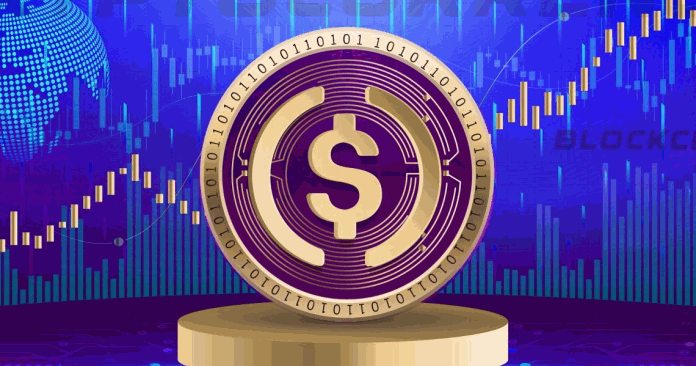
In the world of cryptocurrencies, where volatility and price fluctuations are the norm, stability, and reliability are highly sought after. This is where USD Coin (USDC) comes into play. As a stablecoin pegged to the value of the U.S. dollar, USDC provides users with a secure and predictable digital currency experience. In this article, we will delve into USD Coin’s details, its origins, functionality, advantages, and use cases.
What Is USD Coin (USDC)?
USD Coin (USDC) is a Fiat-backed Stablecoin that was launched in 2018. In simple terms, USDC is a stablecoin that is 100% collateralized by fiat currency or equivalent assets.
The primary purpose of USDC is to address the challenges associated with traditional cryptocurrencies, such as price volatility and the ease of converting between fiat and digital currencies.
With its robust market presence, USDC has secured the position of the second-largest stablecoin in terms of market capitalization, closely following USDT. Its credibility and stability have made it a preferred choice among users in the cryptocurrency space.
How Does USD Coin Work?
The operation of the USD Coin revolves around the concept of collateralization. When users acquire USDC tokens, they deposit equivalent U.S. dollars into a reserve account. This collateralization process is crucial in maintaining the stability and value peg of USDC to the U.S. dollar. The collateralized U.S. dollars are audited regularly to ensure transparency and reliability.
USD Coin utilizes blockchain technology, specifically the Ethereum network, to facilitate transactions and record ownership transfers. It operates on the ERC-20 standard, compatible with various wallets and exchanges supporting Ethereum-based tokens.
Advantages and Disadvantages of USDC
Like any financial instrument, USD Coin has its own set of advantages and disadvantages. Let’s explore them:
Advantages:
- Stability: The main advantage of the USD Coin is its stability. Being pegged to the U.S. dollar ensures that the value of USDC remains relatively constant, making it a reliable store of value and medium of exchange.
- Transparency: USD Coin is backed by a reserve of U.S. dollars held by regulated financial institutions. Regular audits and attestations provide transparency and reassurance to users.
- Efficiency: USD Coin enables fast and low-cost transactions, especially when compared to traditional banking systems. It offers a convenient and efficient means of transferring value globally.
Disadvantages:
- Limited Potential for Price Appreciation: Unlike some other cryptocurrencies, USD Coin is not designed for price appreciation. It aims to maintain a stable value, which means it lacks the potential for significant price gains.
- Regulatory Risks: As with any digital currency, USD Coin is subject to regulatory risks. Changes in regulations or government actions could impact its operations and usage.
Use Cases for USD Coin
USD Coin has several practical use cases in the digital currency ecosystem:
- Stable Digital Asset: USDC provides a stable digital asset that can be used as a medium of exchange, store of value, or unit of account within the cryptocurrency market.
- Efficient Cross-Border Transactions: USD Coin enables fast and low-cost cross-border transactions, making it a viable option for remittances and international payments.
- Hedging and Risk Management: Traders and investors can use USDC as a hedge against the volatility of other cryptocurrencies. It offers a stable alternative for preserving value during market downturns.
- Decentralized Finance (DeFi): USD Coin is widely used in various decentralized finance applications, such as lending, borrowing, and yield farming. It provides liquidity and stability within the DeFi ecosystem.
Comparison: USDC vs. USDT
When discussing stablecoins, it’s essential to compare USD Coin (USDC) with Tether (USDT), another popular stablecoin. Both have similarities but also distinct features:
- Transparency: USD Coin has established a reputation for transparency, with regular audits and attestations. On the other hand, Tether has faced scrutiny and criticism regarding its level of transparency.
- Reserve Assets: USDC is backed by U.S. dollars held by regulated financial institutions, while Tether claims to be backed by reserves that include cash and other assets.
- Adoption and Market Capitalization: Both USDC and USDT have gained significant adoption in the cryptocurrency market. However, USDT currently holds a larger market capitalization.
Is USD Coin a Good Investment?
Investing in USD Coin (USDC) is not lucrative as its value is designed to be stable, similar to holding U.S. dollars. The primary advantage of USDC lies in its utility rather than its potential for price appreciation. However, there are avenues to earn passive income by lending USDC to other crypto investors, although it’s important to note that all investments carry some level of risk.
USDC is a reliable and efficient tool for businesses and individuals seeking fast and cost-effective currency transfers. By eliminating the need for traditional intermediaries like banks, USDC enables seamless transactions while maintaining stability. Its value proposition lies in its ability to facilitate cross-border transfers and provide a stable cryptocurrency solution in the ever-evolving digital landscape.
Conclusion
USD Coin (USDC) is a stablecoin that provides stability, transparency, and efficiency within the cryptocurrency ecosystem. It offers a reliable store of value and a means of transferring funds globally. However, investors should be mindful of the potential risks and limitations associated with stablecoins. As with any investment, thorough research and understanding of the market dynamics are crucial.


